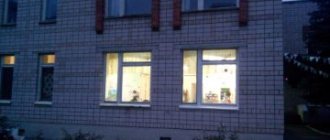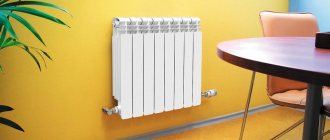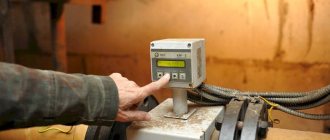Legislation
- Federal Law No. 190-FZ dated July 27, 2010 “On Heat Supply” regulates relations in the field of heating residential buildings.
- Federal Law of December 7, 2011 No. 416-FZ “On Water Supply and Sanitation” in Article 7 of Chapter 3 contains general rules for heat supply of apartment buildings.
- Decree of the Government of the Russian Federation dated May 6, 2011 No. 354 “On the provision of utility services to owners and users of residential premises in apartment buildings” in Appendix 1 establishes requirements for the quality of heat provision (permissible breaks, conditions and procedure for changing fees, air temperature standards).
- GOST R 51617-2000 “Housing and communal services. General technical conditions" regulates the provision of standard levels of air heat.
- SP 60.13330 SNiP 41-01-2003 “Heating, ventilation and air conditioning”.
Actions of consumers in case of lack of heating on time
The season has already arrived according to all possible theoretical parameters, but the central heating in your house has not yet been turned on. Adjusting the operation of the heating main is faster than adjusting the internal heating system and heat supply to the batteries.
Typically, three working days are allocated for commissioning. And if the boiler room shows signs of operation and the apartment is cold, you must perform the following steps:
- Find out about the reasons for the lack of coolant in the apartments from the dispatcher of the operating organization.
- If there is an order from local councils about the start of the heating season, and the heat dispatcher does not give a convincing reason for the lack of heating, then you need to make an application to the service provider organization and the office responsible for heating in a residential building (housing office, homeowners association or management company).
- The application requires the creation of a commission to measure the air temperature in the apartment.
- Measurements should be carried out in parallel with the same actions of utility workers to ensure the reliability of these measurements. To obtain accurate data, the temperature is measured several times in each room. The thermometer should not be in your hands. The thermal measuring device must be state certified.
- Data on the measured temperature are entered into the report. One copy of the act remains with the initiator of the commission.
- Write a complaint to the Criminal Code with an attached report of the measured temperature regarding the recalculation for services not provided. For hourly temperature non-compliance with the sanitary standard, the tenant is entitled to a recalculation in the amount of 0.15% of the monthly payment amount.
All requests sent by you to the Criminal Code must be answered in writing. Each application has a legal deadline for consideration. In the event of a lack of heating, the actions of utility services must be immediate.
The provided response can be appealed to the prosecutor's office or Rospotrebnadzor. Since poor quality services are a gross violation of the rights of residents as consumers.
When does the heating season start?
According to the law, the launch time for the central system occurs in the fall, from October 1 to October 15. The specific date is determined by local governments and given an order by the RSO or CHP. An early start to the heating season is possible when it is less than +8°C outside for five days in a row.
The management company has drawn up a schedule for connecting houses, which they put into action immediately after starting heating. First of all, socially significant facilities are connected: hospitals, schools, kindergartens. Then the valves are opened on the remaining residential buildings one by one.
Dear readers! To solve your problem right now, get a free consultation
— contact the lawyer on duty in the online chat on the right or call: +7 (499) 938 6124 — Moscow and region.
+7 (812) 425 6761 — St. Petersburg and region. 8 (800) 350 8362 - Other regions of the Russian Federation You will not need to waste your time and nerves
- an experienced lawyer will solve all your problems!
This process is necessary to promptly eliminate ruptures and leaks if they occur. The increase in heat level in the system occurs gradually, but the bill will come in full.
ADVICE! In order for the calculation to take place only for actual consumption, you need to install heat meters.
Normal temperature in the house
Many residents demand that utility companies start the heating season, despite the fact that the air temperature in their apartments is normal. In this regard, citizens want to know at what temperature the heating is turned on in their apartments. SANPiN 2.1.2.1002-00 specifies the permissible temperature range in apartments for the cold and warm seasons. Compliance with the temperature ranges specified in SANPiN is a mandatory condition for home service companies, and if the temperature does not meet the standards, then you can file a complaint (we’ll talk about this below).
In accordance with the standards, the temperature in the warm season is 20-28 degrees for rooms. In cold weather:
- 18-24 degrees for rooms.
- 18-26 degrees for the kitchen, bathroom, toilet.
In addition to the permissible temperature, the optimal temperature range is also determined. These two concepts are different from each other. Acceptable is a temperature that does not contradict the rules. The optimal temperature is one that is close to the ideal value. With it, residents feel as comfortable as possible, so they are recommended to insulate the facades and do everything possible to maintain the optimal temperature in the apartment.
It is believed that the optimal value for rooms is 22-25 degrees in warm weather. In cold weather, the range of optimal values is lower – 20-22 degrees. In the toilet, bathroom, and kitchen, the optimal temperature is 19-21 degrees. It is these indicators that must be taken into account when determining compliance with air temperature standards in residential premises. We have almost figured out at what temperature the heating is turned on in apartments. But what if the utilities fail for any reason? You don’t have to suffer in a cold apartment if you suddenly don’t turn on the heating. Where to complain and what to do in this case?
What temperature should radiators be in winter?
If the apartment is still cold when the heating season begins, you need to find out the reasons for this deviation. The most common is airiness in the system, which is easy to deal with on your own. If radiators and pipes work normally, most likely, the standard heat in the apartment does not depend on them.
Standards
Heat transfer standards for batteries are the values established by law for heating radiators, which are necessary to maintain a comfortable microclimate in a living space and are +18...+25°C. They are established by SNiP 41-01-2003.
Minimum and maximum value
Legislation establishes standards for heat supply indicators:
- The battery temperature of +95°C is maximum if a two-pipe heating system is used.
- +115°C is the maximum threshold for houses with a single-pipe system.
- The optimal heat transfer from radiators in winter is +80…+90°C. An increase to +100°C is dangerous due to boiling of the coolant. To lower the heating level, you need to install a regulator.
The minimum value is dependent on the outside air temperature in winter: it increases from +39°C at +5°C to +70°C at -15°C. A specific minimum size has not been established; heating is designed to provide heat in the living space at the proper level.
IMPORTANT! The exact values are indicated in the temperature chart approved for each locality, taking into account the climate.
When will the heating be turned on in 2021?
Turning on the heating in the apartment remains a pressing issue. And here there are conditions for supplying hot water to the batteries:
- Outside air temperature. Resolution No. 354 defines the beginning of the heating season with the onset of average daily temperatures not exceeding 8 °C for 5 days. This limit is associated not only with comfort in apartments, but also prevents the possibility of freezing of systems and unheated rooms of the house.
- We need confirmation from weather forecasters. The cold snap may be short-lived. If forecasts do not promise long-term warming, then there is no point in launching heat supply systems. This fact may outrage residents, who will consider the switching on premature, and they will have to pay for the heat.
The approximate start time of the heating season in central Russia is the first half of October. It is at this time that the weather becomes colder and temperature changes towards high temperatures are unlikely.

Often, along with the start of heating systems, a difficult time comes for utility workers. Problems of an unpredictable nature always happen. Therefore, management companies, as a rule, set a schedule for supplying heat to the houses they service. This is due to the fact that possible problems can be resolved promptly.
Schedule for turning on heating in Moscow, St. Petersburg and regions of Russia in 2021
The table for turning on heating in an apartment for some regions of Russia shows that the heating season will begin on average from the end of September:
| Region | Planned heating start date |
| Moscow | September 26 |
| Moscow region | September 28 |
| Saint Petersburg | 16 of September |
| Lipetsk | 2 October |
| Vladimir | September 27 |
| Omsk | September 26 |
| Ekaterinburg | 16 of September |
| Tver | October 1 |
| Minsk | October 1 |
| Ust-Kamenogorsk | The 4th of October |
| Mound | September 24 (late in some houses) |
| Yaroslavl | September 27 |
| Tula | October 1 |
| Novokuznetsk | 16 of September |
| Voronezh | 2 October |
| Ufa | September 19 |
| Khabarovsk | October 7th |
| Vorkuta | August 23 |
| Murmansk | September 1 |
| Permian | 6 September |
Attention! From the beginning of the dates stated above, heating begins in social institutions: schools, hospitals, etc. Heat is provided in houses and apartments within 2 days after the publication of the Decree of the regional authorities.
Devices
The most convenient and reliable is a portable infrared pyrometer with an accuracy class of 0.5. It takes readings remotely. That is, it is enough to point the bell at the surface to measure and record the value.
It is important that all measuring instruments, the readings of which will be used for complaints to government authorities and legal proceedings, must be operational and accurate. This can be confirmed by having them verified once a year by an accredited organization.
Thermometer
Without a pyrometer, you can check the heat transfer with a regular thermometer. To do this, you need to attach it with a flask to the battery, secure it with tape, and wrap it with heat-insulating material.
How to measure battery temperature correctly
If you have any doubts about the health of the batteries, measure their temperature.
You can measure it in the following ways:
- using a regular thermometer. In this case, add 1 or 2 degrees Celsius to the obtained value;
- using an infrared thermometer;
- using an alcohol thermometer. In this case, the thermometer must be tightly wound to the battery.
The temperature measuring device must have a quality certificate. The error should not exceed 0.1 degrees, and the measurement range should be from 5 to 40 degrees Celsius.
If the battery temperature is significantly below the permissible value, write a request to the management company to take measurements. The commission will measure the temperature of the batteries in your presence to record temperature violations.
Before measuring the temperature of the batteries, measure the temperatures of the hot water from the tap, as these values are related to each other. If the thermometer reading is between 60 and 75 degrees Celsius, then this is an acceptable value.









